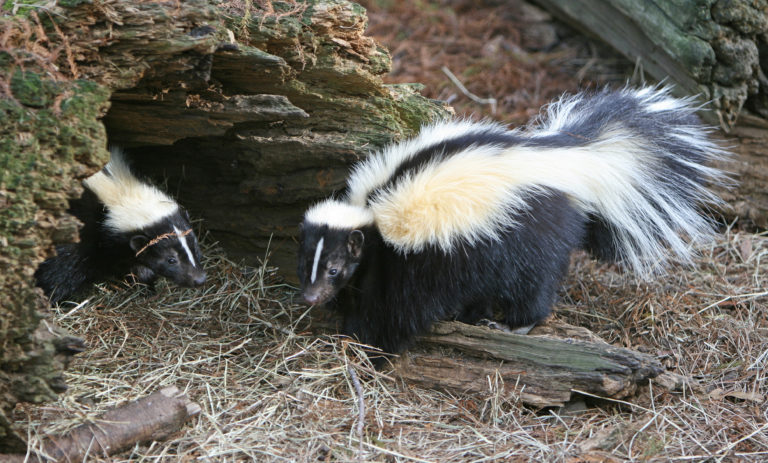
By Kathlean Wolf
Northside News
In late July, I spotted a surfeit of skunks in Warner Park. The three young mammals were loping side-by-side, and from their small size, I deduced that the surfeit (the name for a grouping of skunks) was an adolescent litter, no longer in need of their parents but not yet ready to venture into the world on their own. Their shoulder-to-shoulder passage from one side of Trailsway path to the other was punctuated by frequent pauses to sniff curiously at the night air, and their silent, sinuous motion reminded me of the wave-like ripples in a flowing stream.
Dog owners often experience the unpleasant side of skunks. Any hound foolish enough to ignore a skunk’s threatening dance, the loud stomping of feet and raised tail, is likely to become covered in a fine spray of sulfur-laden musk, a powerful chemical that incapacitates predators. The owner is met by a miserable pet, coated in stench and watering at the nose and eyes. This sort of encounter is the reason many people dislike skunks, and between that and their nocturnal habits, these little mammals are rarely appreciated for their service as insectivores.
This recent sighting near the Warner Wood may be the answer to a mystery I’ve been puzzling over in recent months. A decaying log I’ve visited for several summers to collect oyster mushrooms is now a site of destruction. Soggy wood shavings at the base of the rotting trunk are evidence of some creature pulling apart the wood in search of food, and the oysters are nowhere to be found. The swamp has also been barren of a few previously plentiful mushrooms. In their place are many cone-shaped holes in the ground. Have young skunks been digging up my favorite mushrooms?
Despite the missing mushrooms, I’m quite fond of skunks. I’ve encountered them several times in the past, admiring their neat black-and-white coats and clever, curious demeanor. Like most native animals, their presence is vital to a healthy ecosystem. About half of their diet is made up of fruits and vegetables, mushrooms and tree nuts. Their omnivorous diet includes such insect pests as ticks, crop-eating grubs and Japanese beetles; they also enjoy an occasional meal of wasp nest or beehive larvae. Larger prey includes small rodents, frogs, snakes and bird eggs. Skunks are distant relatives of the weasel family, and like weasels, they occupy a crucial place in the food web.
Though skunks can cause misery to dogs and their families, they are rarely dangerous. Skunks are second only to bats as the cause of human exposure to the rabies virus, a fatal illness. Rabid skunks are much more likely to bite, and may also drool, stagger and roam around during the daytime. Skunks can also carry canine distemper and canine hepatitis. A human bitten by a skunk will need to begin preventative rabies shots within one day to prevent infection. Dogs need regular vaccinations to protect them against skunk-borne diseases, and any instances of a skunk bite should be reported to Animal Control immediately.
Our trio of adolescent skunks in Warner Park will be good neighbors if we’re careful about our interactions with them. While a dog was recently skunked in the Warner Dog Park, the ceaseless traffic of off-leash dogs leaves a scent that will keep most mature skunks away. Elsewhere in the park, dogs and their owners can lower their risk of an encounter by obeying leash laws.
Northsiders living near Warner Park and other natural areas can also help avoid skunk encounters. To keep your property from attracting skunks, block off entrances to spaces beneath homes and patios, eliminate rodent populations and prevent access to food scraps and trash. It’s also important to consider skunks, raccoons and foxes when building and locating some of our favorite urban-farming activities, such as hen-houses and beehives.
Once again, our community has the opportunity to be a model for how to live alongside our urban wildlife. If we’re mindful of the needs of these clever little animals, encouraging them to remain in the rich habitat of Warner Park, we can enjoy having a surfeit of skunks for neighbors.
Have you seen the Warner Park skunk family this year? Stop by the Northside News website and tell us about it.